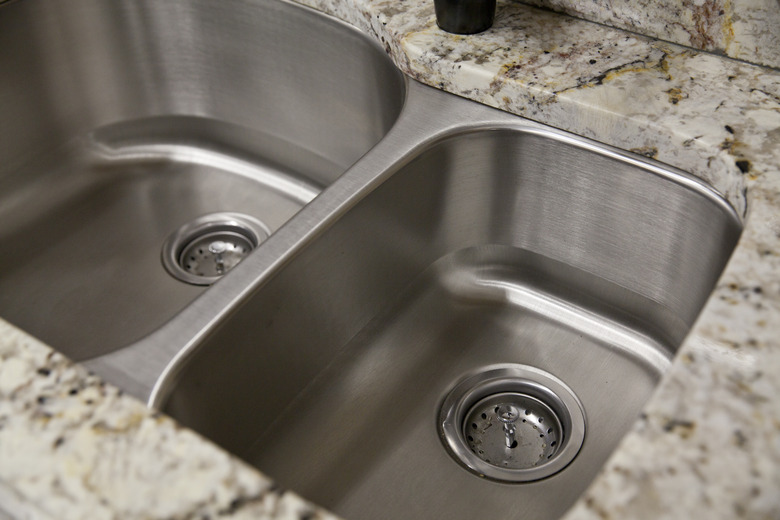How To Install A Double Sink Drain System
The drains for a double kitchen sink typically connect to a single P-trap, which then connects to the drain. You can install a double sink drain in more than one way, but the most common method is to extend a horizontal drain arm with a 90-degree elbow from each sink to a tee fitting that connects to the trap. This arrangement becomes slightly more complicated when one of the sinks has a garbage disposal, but not much more.
Double Sink Drain Connection Parts
Double Sink Drain Connection Parts
The actual drain assembly depends on where the P-trap is located with respect to the two sinks. It's usually somewhere between them, and, in some cases, it may line up with one of the sink drains. Because the trap has to line up with the waste opening in the wall, which you can't move without a lot of effort, its position is something you have to work around.
It helps to construct a double bowl kitchen sink plumbing diagram that begins at the trap opening and extends to the drain openings on the sinks. This diagram will reveal the types of fittings you need and the lengths of the pipes. Generally, you'll need most of the items described on YouTube by Keeney, including:
- a drain elbow for each sink, which directs the drainage horizontally toward the trap
- a sanitary tee
- a short length of pipe to connect the tee to the trap.
These fittings all come with compression fittings that you can tighten by hand. You can buy metal ones or plastic ones, but most plumbers opt for plastic because they are easier to use and don't corrode. If your setup is more or less standard, you should be able to find a double sink plumbing kit that has everything you need.
Assembling the Drain System
Assembling the Drain System
- Begin by installing a drain strainer assembly in each of the sinks. Each strainer has a threaded flange on the underside to which you can screw on a 90-degree waste arm. Extend each arm in the direction of the trap, maintaining a minimum 1/4-inch-per-foot slope toward the trap.
- Cut each arm to length as needed using a hacksaw to create a junction point directly over the P-trap opening.
- Install a sanitary tee drain connector with its sweeps pointing toward the trap. If you need to connect a dishwasher to the drain, use a tee with a dishwasher drain port.
- Connect the tee to the P-trap with a short piece of pipe.
- Tighten all the connector nuts in the assembly by hand.
- Check for leaks and use locking pliers to tighten any connectors that leak.
Variations on the Basic Method
Variations on the Basic Method
The presence of a garbage disposal simply means that you don't need to connect a drain elbow to one of the sink drains. Instead, you simply extend the horizontal arm from the garbage disposal waste outlet using a length of straight pipe. Since the distance between the garbage disposal outlet and the underside of the sink is fixed, you'll probably have to add a vertical tailpiece to the other sink drain to bring its horizontal drain to the same level.
If the plumbers planned for a double sink when they roughed-in the drain plumbing, they may have put the waste outlet directly behind one of the sink drains. That simplifies matters, because it means you can install a vertical tailpiece with a built-in tee on the sink directly over the P-trap and extend a single horizontal drain from the other sink to connect to it.
